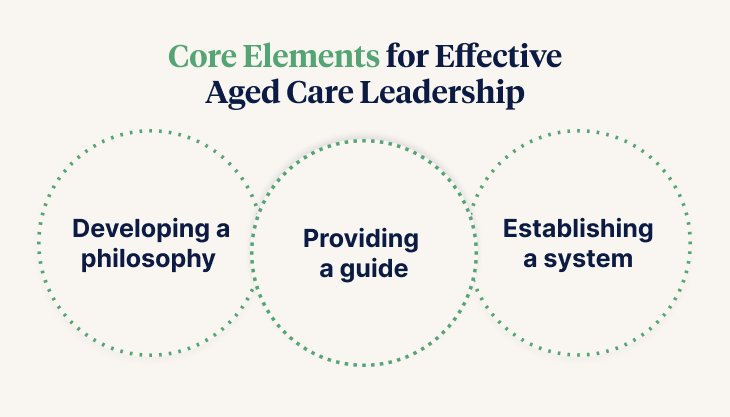A Tool for Effective Leadership and Leaving a Legacy
In a previous article, I discussed whether leadership is temporary or long-lasting and how developing systems can help leaders ensure their leadership is durable.
In this article, I outline what a leader needs to implement to ensure their legacy lasts well into the future.
The core elements of leadership are:
- Developing a philosophy that drives core values and delivers behaviours that achieve the desired outcomes for care and services.
- Providing a guide on how the philosophy should be enacted through practice and behaviour.
- Establishing systems for monitoring the practices so they align with the philosophy and deliver the desired outcome.
Taking each of these elements, let’s explore what they mean in the real world.

Developing a Strong, Memorable Philosophy
It is important to develop a philosophy that is precise and succinct. It should also be easily memorable and referred to when enacting care and services. The philosophy is the formation of the “bond” amongst those providing the services, so they understand the purpose for which they act.
It is important to avoid wordiness, focus on quality of care, and ensure the philosophy becomes the driving force behind all work activities.
An organisation’s philosophy should be a meaningful statement of intent. An example could be:
“The care and services provided to people are based on placing them at the centre of these services and being flexible enough to deliver these as and when a person wants it.”
In this example, the core values are the person and their choice of how they wish to provide these services. This is a user rights-based approach at the heart of the client’s life and how they want to live it.
However, while this is the focus and intent, the interpretation of the philosophy is unlikely to be universal across all those who are responsible for acting upon it. All parties need to be cognisant of any philosophy and apply it uniformly. It is, therefore, necessary to provide a guide to its interpretation.
Bringing the Philosophy to Life: A Practical Guide
The guide should provide clear instructions on bringing the philosophy to life. It should be precise, easy to understand, and cover all areas where care and services are provided. This is not about writing policies and procedures, but creating simple “how to behave” instructions across different service aspects.
A suggestion is to break this down into components such as:
- Onboarding: Formally engaging staff and clients before the commencement of services in a ‘getting to know you’ setting.
- Taking Up Services: This is the initial commencement of services and how the person wants these delivered to their satisfaction.
- Understanding the Person’s Choices: This is how to satisfy their requirements best and build on the relationship.
- Services Provided: This is where a true partnership with the person is formed. Here we determine how various services would meet their satisfaction.
Each component should describe the appropriate language to use (without scripting it), the approach to interacting with the person, how to offer genuine choice, and how to keep the individual at the centre of all care and services.
Monitoring Practice to Keep Philosophy Alive
Monitoring ensures that the organisation’s philosophy remains embedded in everyday activities. However, monitoring should not be reduced to simple tick-box audits. Instead, it should involve thoughtful methods such as questions, surveys, interviews, and feedback.
These activities should ideally be carried out by an independent body that understands the philosophy and evaluates actions, or inactions, against it.
Training and Ownership to Embed Change
No new approach will succeed without purposeful training and support for staff. Once the guide is developed, staff should participate in training sessions to understand the behaviours required.
The guide becomes the foundation for training, and staff should be encouraged to provide feedback on how they would implement it and make the philosophy real in their day-to-day work. This sense of ownership helps foster creativity, active participation, and commitment to the shared goals.
Following training, a buddy system and feedback at all levels will embed the philosophy as more experienced individuals will realise that co-workers become positive influencers, all working under the same philosophical umbrella.
The process can be lengthy, but if you want to make sure everyone truly "walks the talk" in service delivery, ongoing updates, monitoring, and continuous training are essential.
The Leadership Legacy? Following Through
The key to the above is the follow-through and leadership from the top throughout the organisation. Once practices and behaviours are embedded in services, then the leadership provided is also embedded and will live on well after those introducing this have moved.
Author
Mark Sheldon Stemm
Mark Sheldon-Stemm brings nearly 30 years of expertise in aged care, having held leadership roles, including CEO and President of Aged and Community Services Tasmania. His experience spans multiple sectors, including health, education, and retail, with a strong focus on Consumer-Directed Care (CDC). Mark has developed the only full CDC model for residential aged care and provides strategic planning and operational reviews for over 40 aged care providers.
He has also worked extensively to support new providers in their transition to the new aged care system. As a Fellow of the Institute of Public Accountants with a Master’s in Strategic Foresight, he combines financial expertise with forward-thinking strategies to help organisations navigate sector reforms and ensure sustainable, high-quality care.



